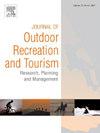Understanding hikers’ injury-risk behavior: Self-categorization processes and self-presentational tactics
IF 4.4
3区 管理学
Q1 HOSPITALITY, LEISURE, SPORT & TOURISM
Journal of Outdoor Recreation and Tourism-Research Planning and Management
Pub Date : 2025-01-07
DOI:10.1016/j.jort.2024.100850
引用次数: 0
Abstract
Hikers experience physical and psychological benefits but also incur injury. In this mixed-methods study, the relevance of self-categorization theoretical constructs (e.g., group norms, normative pressure) to hikers’ injury-risk behavior are explored via quantitative and qualitative analyses. Appalachian Trail thru-hikers (N = 329; n = 85 women) completed an online survey. They indicated whether they engaged in deliberate risk-taking (i.e., taking a riskier route consisting of a climb up a steep rock face, risking injury if they fell) or precautionary behavior (i.e., taking a less-risky route down a seemingly-flat path) and gave reasons for doing so. Frequencies revealed that 82.7% of participants took the riskier route; per a t-test, hikers who took the less-risky route used significantly (p < .01, d = .60) more words in their reasons. Therefore, deliberate risk-taking represented a behavioral norm because 1) a behavior enacted by the majority of social identity group members tends to reflect group-sanctioned norms, and 2) those who do not engage in the behavioral norm tend to use more embellishment (i.e., more words) to defend their deviation. A latent content analysis of reasons identified six group norms (e.g., morality, status) relevant to taking the riskier route and six (e.g., practicality, non-conformity) that were asserted by those who took the less-risky route. Per two themes, hierarchical self-categorizations informed injury-risk behaviors, and social creativity countered normative pressure to engage in deliberate risk-taking. This research provides evidence that injury-prevention interventions for hikers may address theory-based group factors rather than individual risk factors.
Management implications
This mixed-methods study provides recreational professionals who support long-distance hikers with an understanding of group norms that influence hikers’ decisions to engage in behaviors that lead to injuries. This can inform injury-prevention efforts to:
- 1.target groups rather than individual hikers
- 2.be administered where group identity is relevant (e.g., posting information at trail kiosks and shelters rather than online)
- 3.incorporate group norms associated with less risk of injury (e.g., intelligence, non-conformity) and use of safer trail routes
- 4.alter signage at injury-risk locations, and
- 5.involve prominent members of hiking communities (e.g., successful thru-hikers).
了解徒步旅行者的伤害风险行为:自我分类过程和自我呈现策略
徒步旅行者在身体和心理上都有好处,但也会受伤。本研究通过定量分析和定性分析,探讨了自我分类理论建构(如群体规范、规范压力)与徒步旅行者伤害风险行为的相关性。阿巴拉契亚山径徒步旅行者(N = 329;85名女性)完成了一项在线调查。他们指出了他们是否参与了故意的冒险行为(即,采取更危险的路线,包括爬上陡峭的岩石表面,如果他们摔倒可能会受伤)或预防行为(即,采取风险较小的路线,沿着看似平坦的路径),并给出了这样做的原因。频率显示,82.7%的参与者选择了风险更高的路线;根据t检验,选择风险较低路线的徒步旅行者使用显著(p <;.01, d = .60)在他们的理由中多了几个字。因此,故意冒险代表了一种行为规范,因为1)大多数社会认同群体成员制定的行为倾向于反映群体认可的规范,2)那些不参与行为规范的人倾向于使用更多的修饰(即更多的语言)来为自己的偏离辩护。对原因的潜在内容分析确定了六个与采取风险较高路线相关的群体规范(例如,道德,地位)和六个由采取风险较低路线的人断言的群体规范(例如,实用性,不一致性)。在两个主题中,等级自我分类告知了有伤害风险的行为,社会创造力对抗了参与故意冒险的规范压力。本研究提供的证据表明,对徒步旅行者的伤害预防干预可能解决基于理论的群体因素,而不是个人风险因素。管理意义这项混合方法的研究为支持长途徒步旅行者的娱乐专业人员提供了一种了解群体规范的方法,这些规范会影响徒步旅行者的决定,使他们参与导致伤害的行为。这可以告知伤害预防工作:1。针对群体而不是个人徒步旅行者。在与群体身份相关的地方进行管理(例如,在步道亭和庇护所张贴信息,而不是在网上)纳入与减少伤害风险相关的群体规范(例如,智力、不服从)和使用更安全的步道4。4 .改变易受伤地点的标志;邀请远足团体的杰出成员(例如成功的穿越者)参与。
本文章由计算机程序翻译,如有差异,请以英文原文为准。
求助全文
约1分钟内获得全文
求助全文
来源期刊

Journal of Outdoor Recreation and Tourism-Research Planning and Management
HOSPITALITY, LEISURE, SPORT & TOURISM-
CiteScore
6.70
自引率
5.30%
发文量
84
期刊介绍:
Journal of Outdoor Recreation and Tourism offers a dedicated outlet for research relevant to social sciences and natural resources. The journal publishes peer reviewed original research on all aspects of outdoor recreation planning and management, covering the entire spectrum of settings from wilderness to urban outdoor recreation opportunities. It also focuses on new products and findings in nature based tourism and park management. JORT is an interdisciplinary and transdisciplinary journal, articles may focus on any aspect of theory, method, or concept of outdoor recreation research, planning or management, and interdisciplinary work is especially welcome, and may be of a theoretical and/or a case study nature. Depending on the topic of investigation, articles may be positioned within one academic discipline, or draw from several disciplines in an integrative manner, with overarching relevance to social sciences and natural resources. JORT is international in scope and attracts scholars from all reaches of the world to facilitate the exchange of ideas. As such, the journal enhances understanding of scientific knowledge, empirical results, and practitioners'' needs. Therefore in JORT each article is accompanied by an executive summary, written by the editors or authors, highlighting the planning and management relevant aspects of the article.
 求助内容:
求助内容: 应助结果提醒方式:
应助结果提醒方式:


